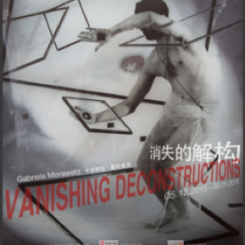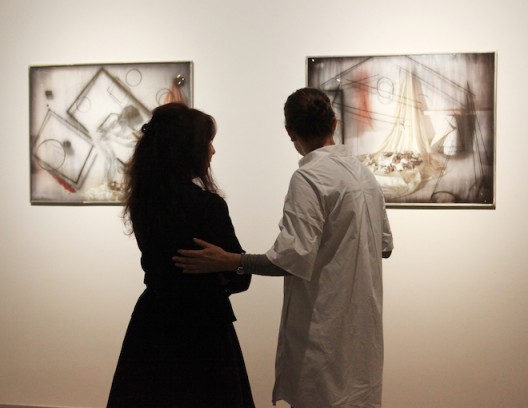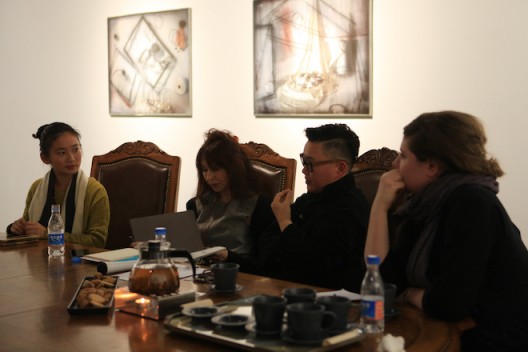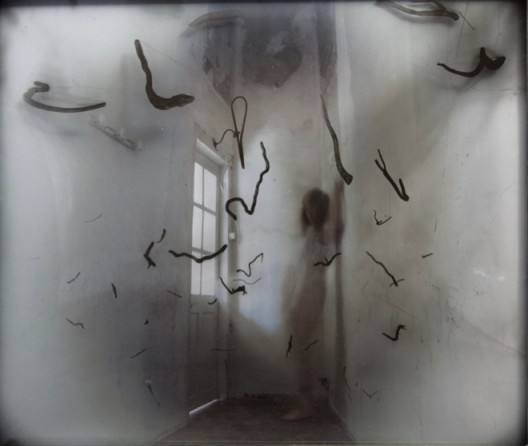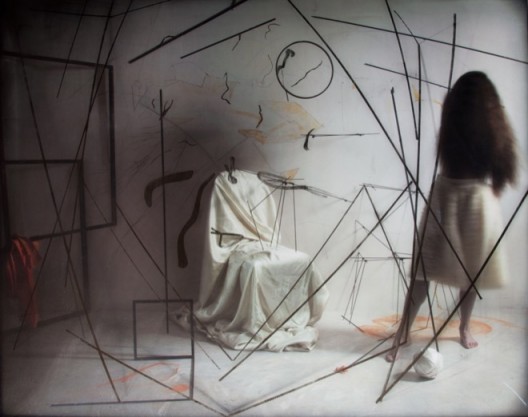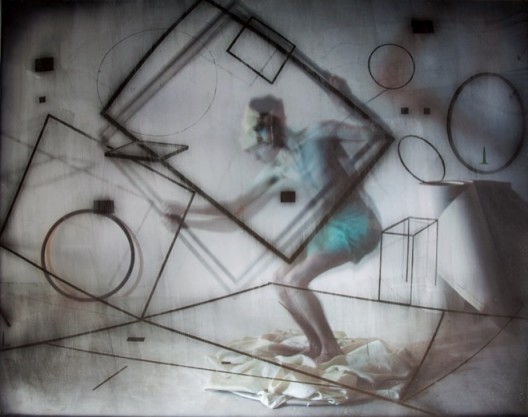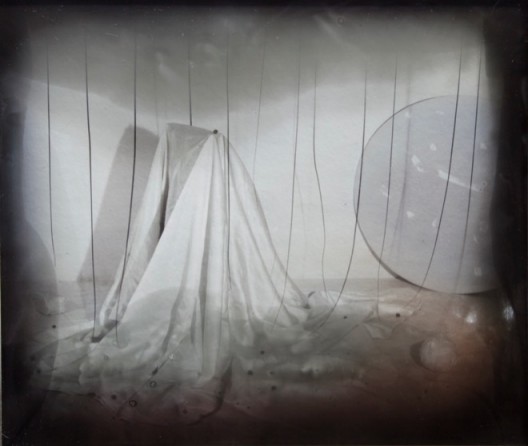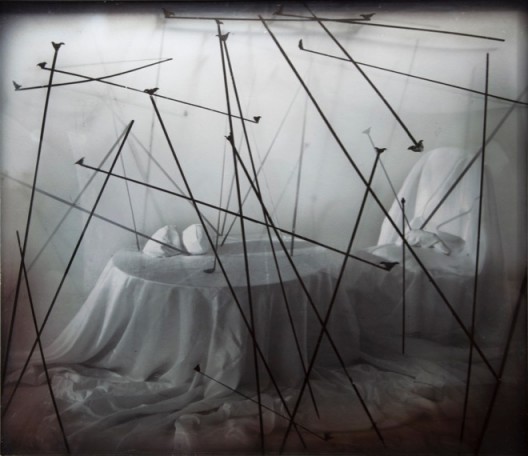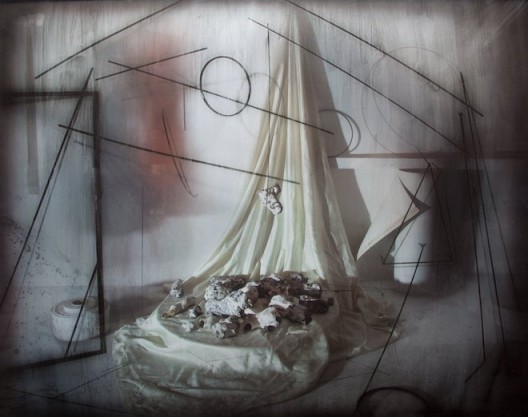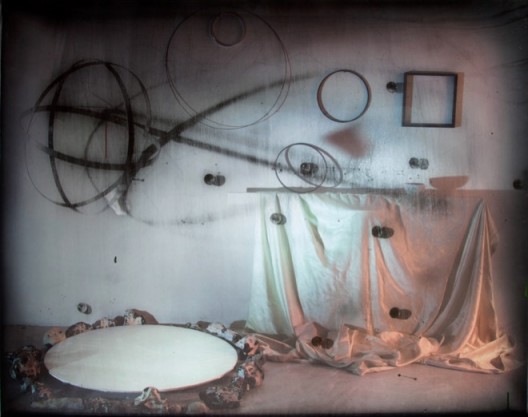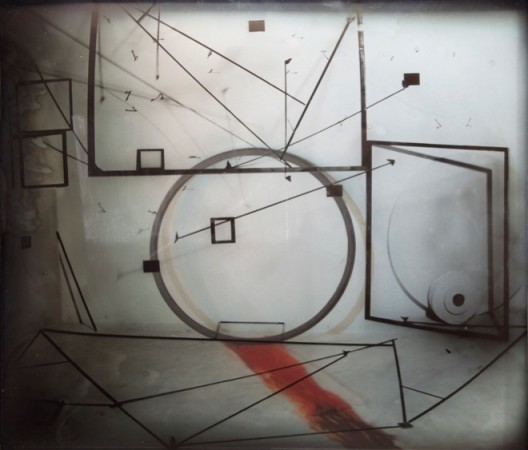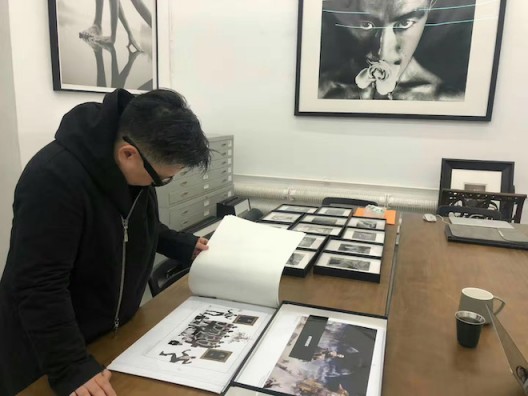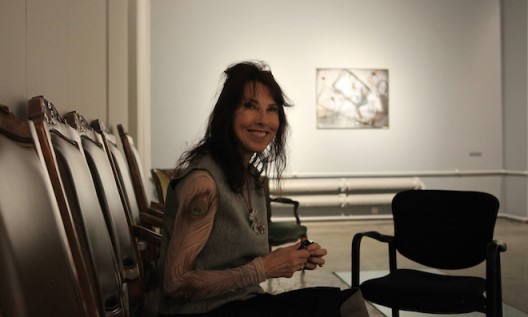See+ Gallery, Beijing, China
December 05, 2015–January 30, 2016
Organizer: Hua’er, Director of See+ Gallery
Moderator: Antonie Angerer
Translator (Chinese): Zwei Fan
Date: December 04, 2015
Q (aka Kyoo Lee, hereafter Q): Thanks, everybody, for being here. Special thanks to Hua’er for organizing this event, Antonie and Zwei for moderating and translating, and Gabriela for creating this beautiful work so that we can all come here talk photography and philosophy! We will have a general conversation first and then open the space up for you all to participate later.
When I first saw Vanishing Deconstructions, I asked Hua’er: “How did you get to meet Gabriela, how did this encounter happen?” Hua’er told me this micro-story of their first meeting—she walked into a photo exhibition in Paris, saw this wonderful work, and spoke with the artist, who ended up saying, “we don’t need words because images connect us.” Indeed, images somehow travel in such a way that we become connected by what we see before or without what we say.
In this show, we encounter so many images. In particular, what we encounter photographically is not only intersubjective in itself but perhaps the inter-subjective itself, as in an inter-view. A communication happens in such an interim space, between the viewers, that is, through this work: now then, how? I will ask this first question, against that background.
As the title of our conversation today indicates, we begin by reflecting on the philosophical and poetic aspect of photography, a kind of philophotopoetics, on a photograph that makes itself or herself: what does this photographic scene see and show? Gabriela, as a photographer, you take or create a photographic image, you create something you saw or something you see, and you make the work show that seeing. How is this act of photographic seeing different from the usual seeing? What is a photographic vision?
Gabriela (Morawetz, hereafter G): That is a great question. I think that the first important thing for me is to get pictures which are not perfect because in that case there is a new field, an open space. I don’t consider myself a photographer in the usual way photographers define themselves but it’s important to note that indeed my point of departure is photography. While I am working with my camera, my negatives, and my chemicals in my darkroom in a very usual way, the approach is still paradoxical because I would like to get out of this photographic kitchen, to cross its boundaries. For me, the point is how to see what I want to see.
We can also start from that paradoxical affirmation of the moment we see (something) we don’t see. This is because we mostly see what we know already but we don’t understand it even when we can see it. My approach would be like to get close to some kind of feelings or thoughts, and following the path like it is Ariadne’s thread. So the question, the challenge, is how to get this thread to get to the place you want to get in. I always try to do this by observing elements from nature, the sphere of being, along with material particularities there.
Q: A great way in. Now then, we have this cliché, our usual metaphor, almost dead, that a photograph “captures a moment.” This phrase is very intentional—almost like animal hunting—and it’s a fairly universal concept, or at least universalized. What Gabriela is saying is countering that notion of intentional framing, right? Intentional in the sense of getting at what you want to see or have already seen in the form of knowing. The point Gabriela is highlighting is rather to let the images appear in such a way that we will be able to see what is left to see instead of what we intend to see. Such elements of contexts and accidents, those otherwise invisible or visible, become very important, “elementarily” significant.
I like to link this counterpoint on “envisioning the invisible” to the very concept of the “photographic.” Photographia or photography, in its Latinic sense, is light-inscribed, something via or with light. Photo-graphy uses light to have or keep an image appear … almost like the command “let there be light.” Just a while ago, Zwei and chatted about the Chinese notion of photography, which is more like “shadow-tracing (摄影shè-yǐng, trace-shadow).” These two aspects complement each other—light and shadow. Curiously, we use different faculties to approach the same thing: the “photo-graphia” looks at the light while “shadow-tracing” turns to the shadow.
Now, to turn to the very idea of inscription or re-presentation too: there is a subtle yet significant difference between representation and re-presentation, about which Vanishing Deconstructions says a lot. If you think about all the tracks, like animal tracks and things left behind, the artistic animals like us—many in this room—also tend to track them again.
So here is my second question. One of the things that captured my imagination and attention in the first place was the very title of the show, Vanishing Deconstructions. As a scholar of contemporary French philosophy where the word “deconstruction” is one of the key terms, I have my own sense of what de-construction usually means or has come to mean in more “academic” senses. In this context of a photographic gallery aptly named “See+,” some other lively meanings of “deconstruction” do appear too, and yet, to remind ourselves, it is about and performing Vanishing deconstructions. So now, it’s your turn, Gabriela, to explain what it could mean.
G: I understand your question on the dichotomy between vanishing and deconstruction. When we use the concept of deconstruction we should be conscious of Derrida’s theory. But what I want to explore is just more of the idea of vanishing, disappearing. I use no words, but instead images. To make images, there is a combination of elements, some well-known objects, sometimes human bodies or nature. They compose an environment which eventually can be interpreted by each of us in a different way. That construction of the world, which is individual, is vanishing through the perception from each one of us. When I do “deconstruction” I am trying to construct my own system of understanding.
“Deconstruction” sounds a bit like “destroying,” but also like constructing something else through the elements of what was “destroyed.” In that flurry of words, there are many meanings of “deconstruction.”
From my point of view, that title is based on the construction of something like spaces which would contain a possibility of metaphor—something that complements. I start with a very minimal material, almost nothing. If you put only one point in an empty space, it is something very important. If you contextualize it through other elements, some kind of narration emerges.
Framed images in my work look very rational because of the geometrical forms, but, at the same time, they are absolutely intuitive and the inner structure is reflected outward.
Q: Again, your description vividly points to this paradox you talked about: the ability of the photographic surface to indexicalize this co-existence of moment and movement. The moment becoming movement and vice versa—such a layered imposition and exposition, each time, becomes Gabriela’s signature “move” or “moment.” Each time, we see what we might call a kinetic photograph, always moving. Something is becoming almost nothing and nothing is becoming something. We have a fairly clear and distinct, semi-Cartesian “rational” moment of focus, and then it goes out of focus at the same time. Such a layered vision in and of space and time is also richly explored in the 20th century contemporary French philosophy, phenomenology in particular, where this dialectic crossing of the visible and the invisible—I am also thinking of the work of Maurice Merleau-Ponty, in particular—produces a constant and productive tension.
And before we invite questions and comments from the audience on what is “photographic seeing” or work, I want to ask you, Gabriela, if you could talk a little about how you would contextualize this exhibition in relation to your works in the past and something you will do in the future. Where do you think you are with your work, the one we see in the gallery today?
So my question is about the philopoetic “spatiotemporality” of your work, your meta-and or intra-photographic focus, so to speak. Martin Heidegger says that everybody has one thought they try to figure out all their life, just like one body, one body of thought. What is that one thought you have, if there is one, any “one”? That one, of course, doesn’t have to be strictly “one,” which has many meanings, itself richly layered and resonant. So what I mean by “one,” especially in your case, would be something like Adriane’s thread of yours we talked earlier: where is that thread, where does it come from, where does it leave, what is its trajectory?
G: I am searching for the way to get into the very inner space which we cannot describe just with words. It is about a desire to enrich the essence of what is impossible to get. The concept of Das Ding is probably something to define and be defined constantly.
Let’s say that I am interested in the mental sphere and in the energy of the unknown.
Q: What or where could be that core that keeps unfolding?
G: I think the creative process is like a destiny. You must continue and search for all kinds of possibilities but it is not a linear process. Once you get into the work, the material character of the things will suggest other dimensions and it is important to be sensitive to those signs. It is like trying to listen to some shimmering voices.
Q: This is a perfect moment to let some other waves to intervene.
P1 (a person, an unidentified interlocutor from the audience): You mentioned the idea of light and shadow, which is obviously the main matter in photography. There is a comparable pair of concepts: emptiness and play. It’s coming to me because just before our meeting we were talking with a group of students of photography. It appeared as a concept because I was talking about the idea of emptiness and its generosity as mirrored in this series of work.
Does the generosity of emptiness mean that emptiness is producing more emptiness, like feeling emptier? Or does emptiness generate plenitude, a plane?—the idea being that, in your culture and art, emptiness is an essential part of the image. I would say that from the occidental point of view emptiness is a kind of fear and we have a fear of emptiness, so we deal with that.
Q: It’s like we want to avoid the void. If I may add, the “cultural” or intercultural point aside, what you’re talking about touches on the absolutely essential, irreducible space in and of art. There is a space for art that cannot be filled in but must be kept empty. A space of freedom. For instance, modern mathematicians and physicists including the “foundational” philosopher Descartes, they debated on the existence of a vacuum. Our ability to imagine the world beyond the visible frame of space is reflected in our avoidance or fear of emptiness. In some sense, then, the photographic reproduction of worldly materials in the form of images, along with its differential constancy, is a fascinating counter-example of this plenitude, the fullness of this life.
G: I think about the image, what it should tell us about the emptiness or fullness. Should it show emptiness as a physical space or rather as a mental state of mind? Should it suggest something like the idea of emptiness? But how? Should that be like a white page? Why white instead of black? It’s obviously not about representation but rather a metaphor of the void. Creating emptiness is creating a possibility of filling it with something which has never been before and is not, either. Then, in order to find that “nothing” we must see through the screen of reality, which is hiding all kind of other spaces.
Q: Through the physical do we access something like the metaphysical. For the sake of comparison, in traditional Chinese paintings the empty space is not simply vacant. The empty space is part of the composition. To give space to that empty space is part of the artistic imaginary. We must bear that point in mind when discussing the importance of the empty in a photographic reproduction of the present. One example from mythology is Pandora’s Box, where the first evil woman was condemned. There is an interesting group of theorists writing about how the camera is like that box. It captures everything, anything (Pan-dora); if you unlock it, everything comes out. It’s a reproduction machine into which emptiness is built, as a condition for the possibility of reproduction. In other words, it itself has to be empty—or to empty itself (or herself) out.
G: It’s a very nice metaphor for the ancient type of Camera Obscura. But does it work for the digital type?
Q: So, has Pandora now gone digital too!
That is about machines, about how they capture the present and how they affect the way we think about photographic materials too. There is a very interesting book by Elissa Marder, The Mother in the Age of Mechanical Reproduction, looking at photographic reproduction from “maternal” viewpoints. It’s a mother-metaphor, a mother’s womb, for instance. It itself, its “self,” is empty, through which figures get reproduced. This is a classical model of the camera. What is the mother in the age of mechanical reproduction? And how does she “figure”? That’s another, endless line of philosophical debate that touches on not only aesthetics but philosophy of and around the “sexes.” We have to pay attention to the material and maternal metaphor because literally this is how the mother’s body is employed and deployed as a camera. It itself should remain empty, pregnant with emptiness—also meaning potentiality.
Another point of interest, even the word, concept, suggests that: to conceive is to get pregnant. So light-writing and shadow.
P2: What I like about this conversation is that it concerns the negative. It is not about making a beautiful image but trying to show the background, an opening that sets your emotion, a certain condition of attentiveness toward something beyond any pre-conceived ideas; these days we are constantly bombarded with pictures. So instead, I wanted to stress the practice of setting yourself into an emotional stage, into a certain mood, through staging the thing. Or even just getting up brings you into a position of being able to be empty without feeling empty.
G: The idea is how to make emptiness radiate in a positive way. Usually its meaning is associated with some kind of negative feeling. While we are talking, I also sense how the process and series of work, so rich with all kinds of elements, maybe even too many, also illustrate my own fear of emptiness. There are two opposite states: emptiness and fullness. But the question could be the “emptiness or fullness” of what? What is the vessel which contains them?
There is poetry by Gherasim Luca who wonderfully developed that concept.
But the process I am interested in is the transition between the state of emptiness and the moment of taking a creative action.
Q: And not just what this emptiness means but how emptiness functions.
G: It’s very important, probably for everybody, but especially for the artist to arrive at that moment of “floating states.” Take on those eternal questions such as: Where are we? Who am I? What am I doing? Where is the sense of the existence? All of those questions are essential and they are coming from the anxiety in front of the emptiness of the universe.
Q: Running with this theme of paradox, this show offers an intriguing example of how remembering and forgetting are paired. In order for us to remember anything, we should almost be able to forget, so to speak. To re-member is to be able to make it a member of something. The human beings are those animals who keep promising because we have a sense of future and of failure. I will meet you tomorrow at 2 o’clock! I promise! I owe you $5, I will pay you back! I will do this and that—a promising animal. But that requires us to be able to forget, to get beforehand. Nietzsche, too, saw that jagged paradox coming: if we do not forget, we cannot remember. The process you relate to resonates with that. An example of this emptiness in a more performative sense would be: you reset yourself through a happy new year, or shall we say, “empty” new year. Likewise, there is a kind of existential dynamic in a photographic vision: something else gets freed when an image freezes (the moment)—in a sort of serial syncopations.
P2: I like the concept of the camera as the mother’s womb. But then, what is the image? In the end, the image is not a reality. The image is also flattening things. The three dimensionality of a certain body is described by the shadow that is moving, so the kinetic aspect is very important. When Gabriela’s images offer a view, they perform the viewing in an objective way.
This is a motherly emptiness, the actual ritual of taking the camera, putting it in position where you could get into those in-between moments. What are the different aspects among the camera, the body, the image, and the woman? What are the parallels in these metaphors?
Q: Precisely! What you’re pointing to is the mystery of photographic transition, transposition, transference, anything that moves. Something is on a plane of consciousness, carried along and over (also as in meta-phor). Like a mother’s womb, we think about the metaphor, we think about generosity in the gene, genre, gender … as Derrida also points out. It is what it is, what we cannot see.
P2: And its potential.
Q: Yes, so that’s why there’s a constant repetition of that which re-appears and re-presents. It’s a series of mediations at the heart of which is the mother’s body. I joke to my students in my gender philosophy class or dis-seminar that the word “reproduction” should be banned! It’s not re-production, it’s production.
G: That’s why I want to defend the idea of uniqueness even while using a technology of reproduction. A unique piece in photography means that it returns to its materiality. It becomes also an object—the image’s own materiality. There is only one “product” related to the mother’s body as a unique child.
Q: The mother’s body is not a Xerox machine! But somehow patriarchal politics treats the woman’s body as if it were or could be just that. The idea here is to honor and value the uniqueness of each being, in the sense of and with respect to its potentials.
P4: I believe the standard of the arts is measured by their philosophical quality. I just came to see the exhibition and I also see how the highest standard of the arts is met by these philosophical questions!
I hear wonderful metaphors, especially the photographic kitchen. In the kitchen it’s always a lady, that’s always the one reproducing also as in “social reproduction.” I see the connection you mention between the mother’s womb, the reproduction and the kitchen—it’s a lady that links.
In Chinese, we have a clear sense of an artistic birth, the birth of a work. Even a male artist, we do not tell if it is female or male. In Chinese even when we talk about a male artist, if the talk is about a creative moment, we would say that the baby is “stuck” at the moment or in the process of birthing, something to be “pulled out of the womb.” All artwork is like giving birth to a baby.
I see this connection across different cultures. In terms of that emptiness, in the Chinese context, the “hundreds” of everything coming together as a unity is also in a state of emptiness. Everything comes together and gets integrated. This state of emptiness is also Wu—there is something and nothing. Emptiness is related to nothing as in Wuwei (non-striving, inactive activity), so in the time-space, it has an original time and also the end of time. Emptiness is a background to consciousness; beginning of time, end of time, through lines.
G: I was also interested in the idea of the term, “in illo tempore.” It’s a Latin term which can be translated as “in that time” and Myrcea Iliade develops that idea of archetypes. That time means time without any time. It could be in the beginning of time, throughout, or in the end. It’s about the vision of the receptacle which contains emptiness but is not really empty. It’s filled with concepts, symbols, metaphors…from the beginning of time.
Q: It’s also about a bodily immersion, as we say in the middle of. Of doing things, of being, so the ego has to be evacuated. I’m thinking of the Chinese notion, Zhong (middle), which for me also means something like a quietly orchestrated con-temporaneity of the concurrent.
Now, I want to loop back to the beginning of your talk, how you say you are trying not to frame things in advance. To let things be in the middle. That’s the magical, soft “catch” we are looking for. This emptiness and nothingness or middling. Middling without meddling. It has ancient resonances, both Greek and Chinese. “Middle Voice’ is like that in ancient philosophy—it is neither this nor that. In your work, I see it happening as a quiet, photographic pitch in the middle (of nowhere). You pay closer attention to where the baby’s head is stuck. A labor of meta-or intra-photographic midwifery, this kind of visual poetry, philosophy, artistic creation, that’s really helpful. The emptiness there also enables an inner shift of focus from the negative to the positive, trans-generating a sphere of creativity. That requires a certain resignation of agency, literally the agent, the “one” doing this or that or rather dying this way and that…you have to let the work work.
P5: The first word that comes to mind is an egoless perspective. All the past, present, future, design—they all start dissolving. I would see it as quite positive, similar to chemicals that lots of members from British art world take to gain emptiness, to gain exploration and space. Complete emptiness, an extreme state from which to create a new art of painting or music. So that’s another perspective on emptiness. Emptiness could be quite abstract, so I’m wondering: from your experience, how do you visualize that part of the visual layers of emptiness?
G: If I understand, you would like me to tell you the process, how this work of mine happens that way. I could answer like this: At the beginning of all, there is nothing, then some small element appears, which becomes a central point of the construction of the space. At that point, the empty space is not empty any more. It is already constructed, designed with lines, squares or circles. The objects can be really very ordinary, but at the same time I care about and take care of the emptiness of their own. Their shape should also express emptiness.
Such a constructed space at that initial stage is a kind of envelope for the other, an inner-theater. So talking about materials, there is still a symbolism of emptiness because of the in-betweeness of both layers. The idea is to convince the space to become symbolic at that point. Earlier we were just talking about it, comparing it to the fruit or an object from which you are taking out its mass. Then, the container is getting empty and gets filled again with new images, new realities. I don’t like to use the word “image” because it is flat. Rather, reality has all kinds of forms.
P5: Your remark illuminates how you construct layers, which is quite hard, and it is why, I think, your work creates distortions, using different tools to strike a new reality, an image’s own reality.
Q: So the procedural dynamism of emptiness is also quite literal, right? Such kinetic connections between pictorial spacing and photographic timing we have been exploring also help us move onto the next and final phase of our discussion, which is to look at some specific examples of Gabriela’s work. Let us see how those themes we discussed materialize, how they matter there.
Following on that question of emptiness, the life itinerary, your biography, exhibitions and locations where you worked, if we look at your work, so far it involves a lot of travels, moving around. You have various experiences in different locations. There are also artists who literally never leave their nest, but as you lived and passed through various spaces, I am interested to hear your thoughts on the role of memories, experiences and travels in your art. I imagine that these series of forms of life would force you to empty yourself out of your comfort zone. How does that “produce” your mind? Well, to experience is to live OUT OF the limit, to ex-perience.
It means you have to trust that emptiness, that space you are jumping through and sometimes into. It’s a fascinating image. You have to allow space in your lifeboat. For those of you who travel a lot, every time you travel, you must pack the absolute minimum and then you have to empty it out. Or at least that’s how I try to travel. When you leave for a new place, you must also leave some room in your luggage. If your suitcase is full, you won’t be able to add anything else when moving to a new place. Again, the wisdom of leaving some space is about underdetermination. From the way I experience your work, that kinetic, convex mirroring, that space works like a slightly empty suitcase. So the photographic kitchen itself is on the move. It enables a constant mirroring so that you won’t lose that inner eye, that inner core space, as you’re going on a space-trip, too.
So how does this literalized movement of ex-periencing impact the way you produce work? I ask this question because the work you produce is almost ritually layered and materially evocative in ways that seem to reflect and even stress various traces of time and space. There is an allegory.
G: I really agree: you have to trust that emptiness, that space we are jumping through. It is an essential feeling in every displacement and a real experience as in crisscrossing the sky. It means also: don’t be afraid, go ahead.
I don’t feel that I belong to some particular space. Although I have been living in France for a long time, enough to feel home there, it doesn’t mean that it produces something like lightness. Yet, not being attached to some particular space or community in a very tight way doesn’t produce strength, either. Still, my main working studio is in Paris where I live, and I must say that that is the material space where my ideas are taking shapes.
When traveling, being somewhere else, on the move, open to understanding others as well as others’ understanding of you … such is always a huge invasion of your own comfort zone. But this is exactly that idea of emptiness. You become the vacuum space in order to receive all kinds of new experiences—you must make space for that. Coming back to my own space, I see there is an issue of how to classify all those experiences and how to absorb all of that space, of emptiness-fullness.
Q: From what we’ve heard so far, along with many wonderful images and ideas, I feel like I am beginning to have a photographic memory of what you have been describing on that space of emptiness and that emptiness is an envelope of the other.
P3: An envelope is a space, so actually it offers a particular space and fold.
G: Something I think about is the concept of not knowing. There are moments in life and particularly in every artist’s practice of getting to the point of doing something without knowing why and what it is. How can you understand it? You probably become very afraid of that unknown object created by yourself, and you just need to follow that work. The idea of getting deeply inside this unknowledge is very interesting.
P4: Your idea of unknowing is about self-consciousness or lack thereof?
G: No, it’s really about not knowing. Something appears in front of you because you are going forward but you don’t understand why, what its real content is, what the real meaning of that object is. There is a paradoxical situation in that because if you are doing that it means you know but you don’t know why. It seems like the two sides of the brain get disconnected at that point. It is important to consider that space-time of not-knowing as a fully valuable process. It is probably something related also to emptiness as a condition of creation.
P3: I have a friend who immerses herself in a room or a strong force gives her an inspiration, so she is somewhere just writing, and unconsciously producing, whether it’s writing or not, in a state where she create something because she us possessed or emptied, I’m not sure.
G: There is something like a third thing, a third space, which is AVIDIA, something to study more about. It’s about space, this particular space in between where you can see the shape of things but you don’t know what’s inside and what it means.
Q: I think it is linked to the question of the exteriority of the envelope, the difference between bribery and the present, for instance. Consider the notion of gifting: when you give someone a gift and also when you are “gifted.” You don’t know what it is you’re given when gifted, and what you’re gifted in. It’s a kind of pure thanking, and, as with Heidegger, Danken, to think is to thank. The difference between bribery and a gift is this: I give you ten yuan so you do something nice to me, you know what you’ve given and are receiving in return; but, I give you a gift in an envelope, you just take it, just receive it, don’t question it, and you don’t actually or fully know what could be inside, metaphorically and literally or both, even after you’ve opened it or think you have. It could be a bomb, too, including a time bomb you don’t see now; Derrida talks about this in the classical Greek, “pharmakonic” parable of writing as a gift given and to be disseminated as such, as both a medicine and a poison. That’s the limit and risk of it. That’s the aporia of gift-giving. It’s also an artistic notion, an artistic “gift” inseparable from the notion of freedom. An artist as one who responds to a call, you just follow it but you don’t know what it is.
That ties back into beginning of our discussion of not trying to do this or that, but the question then comes down to framing. All the frames in these photographs, as you say, are not very intentional. It’s there to leave the space of not knowing, leaving it active and let it speak. That seems to be the ethos, character and the momentum of your work of “shadow-tracing.”
This notion of passively powerful “gift” is very important especially today. What is the space for the arts in this hypercapitalized world of micro-transactional calculations? We talked about reproduction, some people will produce something with the preexisting model of what is acceptable, what is popular, what “sells,” what is “catchy,” etc. There is something about unknowing as a value of and vehicle for irreducible freedom no one can take away from us, which is really real. This also reflects, it must be said, a discursive tension as well as reciprocal tie between the critic and the artist, where the critic wants to know everything about a piece, taking it apart, wanting to know every move, every sign, while rendering it more visible.
G: The idea of freedom and space tied to unknowing is very intriguing. There is a great freedom for all the interpretations when there are no any instructions for understanding but it becomes also a source of anxiety because you cannot access the essential and hidden meanings.
Q: Oh, don’t worry, I will sign and seal your envelope! I can sell it for you! (Laughter) So, leave that envelope sort of half-open so that it can interact with this otherness you also describe through your own experiences.
Speaking of such deconstructive “framing,” I’m also intrigued by the geometrical figures in your work, the free-floating, naked bodies, and the very mathematical, superimposed work. It’s also your own body. Are we seeing images of your body sort of naked or semi-naked? If you are interested, would you mind talking a bit about what you have given us in that regard?
G: Maybe I am thinking about this particular idea of geometry; or maybe I am thinking against the geometry? Once again, I am in the opposite side of what it looks like! Explored here is a sensitive approach to geometrical shapes which are by definition rule-bound. But how to construct such a space with minimum elements and without mathematical calculations: my approach is a bit random without any particularly sophisticated structures and necessary systems, and it is also an autobiographical process because all those elements used here belong to my familiar environments, as they also become part of other works or part of collected objects. Why do I collect things? I am like a magician always surrounded by some artifacts to play with. Sometimes human beings take sensual approaches to the question of existence, which are important to them. And there are shadows of all those elements, another space inside the image. We have been talking about deconstruction and its meanings, all those elements penetrating one another and all those things even include something that does not exist in fact since it is an illusion or ephemeral effect, basically light and shadow.
About the process: it’s very important for me to be emotionally creative and to be able to arrive at the synthesis of everything at such emotional moments.
Q: Listening to you, I realize your work is also about the unframeable richness of framed ambiguities. We all carry our coffees or cages around, which could also be a window that frames and frees you, all sort of portals into another world within a world, both portable in themselves. In that connection, something about the rectangular, the surface of life that annexes itself, is really interesting, its inherent metaphoricity: I mean, it is and carries its own frames. That self-reflexive or self-referential tension is what remains so arresting, what forces us to look. Look! And shadows are this photographic work … another layer of ambiguity.
G: Maybe the next exhibition could be the installation of emptiness and its shadows!
P6: I want to ask about the glass you have, also the mirror. Did you deliberately choose your own materials?
G: Yes, the materials are important—it’s all about my approach to photography. It’s not only the matter of image. The image is absolutely connected with the surface because each material is producing a perception of what we can see, each time differently. It can be cold, warm, soft, pleasant, or unpleasant to touch, and so on.
P6: I notice you use a mirror a lot. Can you speak about that?
G: You are right and there are other reflecting materials like water or the black surface of shining glass, etc. There is something about something (else) being reflected inside but it’s mostly about creating another possibility of perceiving the real. Also there is certainly something from the myth of Narcissus, which always appears when we talk about the mirror. When you are reflected in something, you still see the surrounding world, so you are included in the whole image and sometimes it is much stronger to show that through a mirror than to show it frontally. It’s kind of turning everything upside-down and inside-out.
P7: I have one final question and then we can go for dinner! It is about the perception and moment of illusion or irritation. I remember the first time I saw your works on the wall and thinking: is it a shadow, is it not a shadow? We talked a lot about how the works are expressions of your inner emptiness and how your creative unknowing of what you see creates a kind of original moment that is this emptiness where you, without thinking, constantly get and get out of such images. So, I wonder how much of this is part of your working process.
G: I’m always searching for the magic moment. An important thing in general is the emotion of being close to some new, unknown point where the habitual perception reaches another level. The motion between the matter and the psyche generates those emotions, the main elements in my creative process. So such a material emotional translation has a big influence on the image that results, along with the clear and confused perception of it. This moment is crucial.
Q: Most importantly then, this is the moment for us to say: thank you!
Kyoo Lee, a member of AICA-USA,the author of Reading Descartes Otherwise (Fordham University Press) and a forthcoming book on visual culture (The MIT Press), is a transdisciplinary philosopher, writer and critic, who currently teaches at the City University of New York where she is Professor of Philosophy. A recipient of fellowships and visiting appointments from Cambridge University, CUNY Graduate Center, KIAS, the Mellon Foundation, the NEH, Seoul National University and Yanbian University among others, her philopoetic texts have appeared in AICA-USA Magazine, Asian American Literary Review, The Brooklyn Rail, Flash Art, PN Review, Randian, The Volta and the White Review as well as various standard academic venues.
An editor active in various fields, she is the chief co-editor of philoSOPHIA: A Journal of transContinental Feminism, and serves on the editorial boards of Asian Journal of Women’s Studies, Bloomsbury Studies in Critical Poetics, Derrida Today,Open Humanities Press, Simon de Beauvoir Studies and Women’s Studies Quarterly. She is also on the board of directors at Litmus Press. Her Mellon-funded anthology, Queenzenglish.mp3: poetry | philosophy | performativity, with contributions from 50+ poets, musicians, theorists and performance artists from across the globe, has recently been published (2020).
Throughout her site-specific cogitographical practices and collaborative projects, Q Professor Lee explores co-generative links and zones between critical theory and creative prose.
Gabrieal Morawetz, born in Rzeszów, Poland, is a photographer and visual artist based in Paris, France, who also works in painting, graphic design, sculpture, installation, and video. A graduate from the Academy of Fine Arts in Krakow and the Instituto Nacional de la Cultura in Caracas, Venezuela, her works that are richly liminal, metaphorical, and dynamically intercultural, have been exhibited internationally at prominent art institutions such as Chicago Cultural Center, San Antonio Museum of Art, Yerba Buena Art Center, Rubin Museum of Art, Museum of Contemporary Art in Caracas (MACSI), Fotomuseo in Bogota, Te Papa Museum, and Art Museum in Kathmandu, as well as art fairs such as Art Paris, ARCO Madrid, Art Bologna, Paris Photo, Photo Shanghai, Aipad, and Photo London. In 2011, Descartes Et Cie published Gabriela Morawetz: Ne faire qu’un (PUBLICITÉ) as part of its celebrated AREA series, documenting her pieces from 1992-2011, with text by Anne Tronche, Marek Bartelik, Serge Fauchereau, Edward Glissant and Joanna Sitkowska-Bayle.



